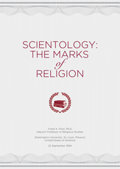In terms of religious practices, Scientology possesses the typical ceremonial religious forms which are found among the world’s religions, namely, initiation or baptism (which is called “naming” by Scientologists), marriage, funerals, etc. However, a central religious practice unique to Scientology is auditing, which can be compared to the progressive levels of meditation among Roman Catholics, Buddhists and Hindu Vedantists. Concomitant with auditing is Scientology training, which I will discuss at greater length in para. III (b).
(a) Auditing is a religious instructional type of process by which spiritual guides (trained Scientology ministers) lead adherents through the states of spiritual enlightenment. Scientologists believe that by actively going through this gradated auditing process, they help to free the soul, or “thetan,” from its entangling afflictions or “engrams.” The stages of auditing are called “grades” or “levels,” and these are shown on the Scientology “Classification, Gradation and Awareness Chart.” This chart depicts metaphorically the span between the lower and higher levels of spiritual existence. Scientologists call the chart “The Bridge to Total Freedom” or, simply, “The Bridge.” The Bridge details the spiritual continuum, ranging from negative “unexistence,” through middle level “communication,” “enlightenment,” “ability,” and finally to “Clearing,” “source,” and ultimately “power on all 8 dynamics.” The vast bulk of Scientology religious practice is devoted to auditing and training courses for enlightenment and the training of auditors, who are the Church’s spiritual counselors. These gradated stages are remarkably like the stages and levels of religious and spiritual illumination in the noted Christian treatises Journey of the Mind into God by the medieval Franciscan theologian St. Bonaventure, and the Spiritual Exercises by St. Ignatius of Loyola, founder of the Jesuits. The spiritual goal of auditing is first to become “Clear” of harmful “engrams” and then to become a full “Operating Thetan” (OT) so that one is “at cause,” over “life, thought, matter, energy, space and time.” While not opposed to consulting physicians for physical ailments, Scientologists are firmly against the use of psychotropic drugs which they believe impede rather than assist the attainment of mental and spiritual healing of the soul.
(b) The other central religious practice of Scientology is training, which involves intensive study of the Church’s scriptures. Although one important aspect of training is the education of individual auditors capable of ministering auditing to parishioners, auditor training has an equally important individual, spiritual component as well. As discussed below, this spiritual element is in keeping with the emphasis of Scientology and Eastern religions on meditative and instructional worship rather than on celebratory worship which prevails in most Western religions. Scientology doctrine states that training provides fully one-half of the spiritual benefit parishioners receive in moving up The Bridge.





























